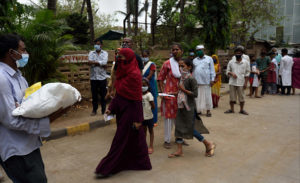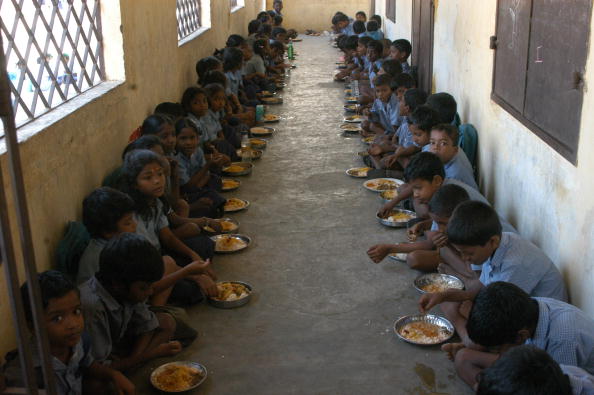Promises to provide dry ration in lieu of midday meals for nine months fell flat with an RTI response revealing that some schools distributed ration for four months while others managed just one
In 2020 due to the disruption caused by the pandemic in the functioning of schools the Central Government’s mid day meal scheme also suffered a setback. In view of this the Delhi government started distributing dry ration kits among the students enrolled in government schools and government- aided schools from nursery to class 8. The kit included wheat, rice, pulses and oil. Around 8,00,000 students were to benefit from the scheme.
Announcing the move, Delhi chief minister Arvind Kejriwal said last year, “When schools were closed, we decided to send the money for mid-day meals to parents’ account, but now, it has been decided that we will give dry rations for six months.” The main aim of this scheme is to ensure adequate nutrition in children and to incentivise families from lower income groups to send their kids to school, as such ensuring the continuation of the mid day meal scheme during the pandemic was important to retain the enrollment of children in government schools.
RTI response says NGOs/service providers had to provide ration for nine months (July 2020 – March 2021).
However, despite claims and announcements the on ground implementation of the scheme is lacklustre. To find out more the Patriot talked to the managements of various schools, students and RTI activists, and found that not all the students are getting rations as promised.
In Government Boys’ Senior Secondary School (GBSSS), Rani Bagh students did not get the full kit, “I only got one fortune oil packet, and pulses. Since now I have been promoted to the 9th grade I am not getting anything.” says Vineet (name changed), a student of the GBSSS.
Talking to government – aided schools we found that while some of them were distributing ration, others claimed they did not get anything to distribute. “We did not receive anything to distribute to students,” said the Vice Principal of a School in East Delhi.
In the RTI response that Patriot accessed, schools denied that they did not distribute ration. However, there were inconsistencies in their responses and the data provided. A majority of schools did not distribute rations for the promised nine months, some schools provided ration for six months only (July 2020- December 2020) in two batches, while others provided rations for just four months. There were also a few schools like Govt. S. CO-ED. V. Rani Khera, Government Girls Senior Secondary school No.2 Mubarakpur Dabas that provided ration only for one month.
Other the other hand schools like Government Girls Senior Secondary School, Mubarikpur Dabas, Sarvodaya Co-ed School, Rohini, G.G.S.S.S, Sultanpuri, GBSSS, F- block, Sultanpuri, stated that they only provided ration for four months (July 2020- October 2020).
The Delhi Government gave contracts to NGOs/ Service providers (mostly those who were serving mid- day meals) to provide ration kits in schools and schools distributed the ration, while in some schools these agencies directly distributed ration. According to the Directorate of Education (DoE), the dry ration being provided per day for primary students (up to class 5th) is 145 gram and for upper primary students 217 gms (classes 6 to 8), So, the total weight of dry ration kit for 6 months period is 20.175 kg for primary students and 30.383 kg for upper primary students.

A worker from Maitri Research and Development Foundation, one of the service providers who got a contract to distribute ration kits told us that, “our work is to do packaging and sending ration kits to schools as they demanded.”
Rinku Arya, a social activist recently filed an RTI about distribution of dry ration kits, and the response he received from most of the schools was that they all distributed ration kits to the majority of students. But, he said it did not happen on the ground. “Childrens of migrant labourers study in government schools, and since the lockdown many were in their home states. So not all students got the ration.” said Arya. “The procedure is that the school would call students and they would come with their parents to receive the ration kit. But during lockdown communication was a big issue, also the distances to the schools were a big hindrance for students”.
Suraj, a community mobilizer working with the Aaina foundation told us, “I also worked in ration distribution, my school in Shakurbasti asked us to help them to connect with students and help them distribute ration. It happened very smoothly.”
An official from the Directorate of Education said that, “Ration is being distributed as per promise. There were some disruptions due to Covid, but the ration was distributed accordingly.”
The Mid-day meal scheme was aimed to provide better nutritional standing for school children. The Food Security Act, 2013 guarantees children in the 6 to 14 age group one mid-day meal free of charge every school day in government schools. The law also provides that if food grains are not provided a person is entitled to get food security allowance. During Covid- induced lockdown, the mid- day meal scheme was stopped that mostly affected students from low income group families.
As per the scheme 450 calories and 12 grams of protein for children in the primary classes, and 700 calories and 20 grams of proteins for children in upper primary is to be provided. Experts believe that nutrition security was the most affected due to disruption brought on by the pandemic.
Jean Dreze, development economist, told Firstpost, public distribution does not have nutrition security, “It can provide nutrition intervention.”
“Why doesn’t the Delhi Government provide eggs?” asks Arya, adding that food grains provided were not enough. “Many students couldn’t receive food grain kits, so we demanded that some amount should be credited in account of students as a compensation.”
Even when the food grain kits were provided, they were not enough. “At home we just don’t use wheat, rice, or pulses. We also need spices, vegetables to cook. Families have been affected by Covid, and the government must think about this issue. Ration kit alone can not help them”, says Arya.





